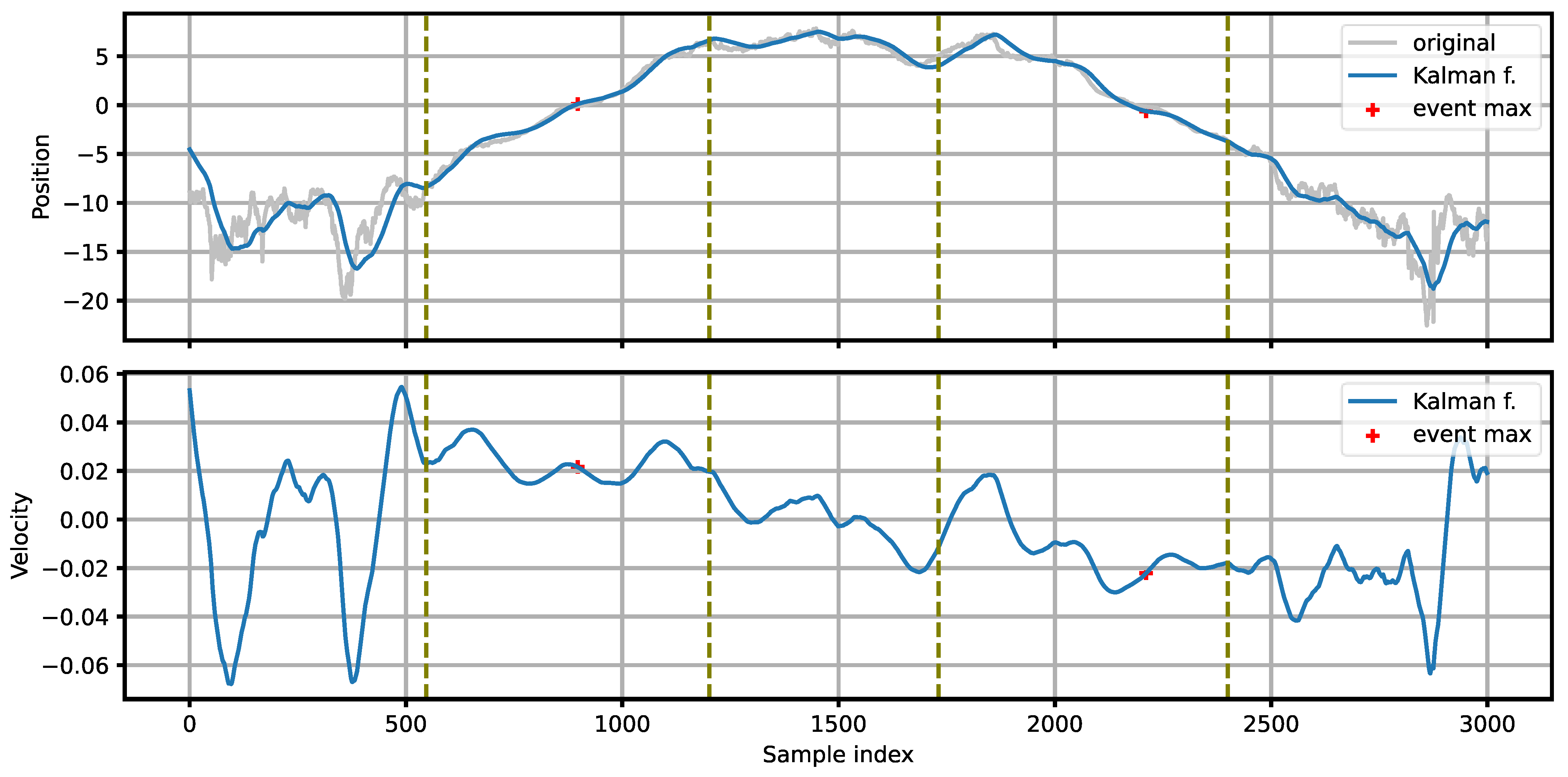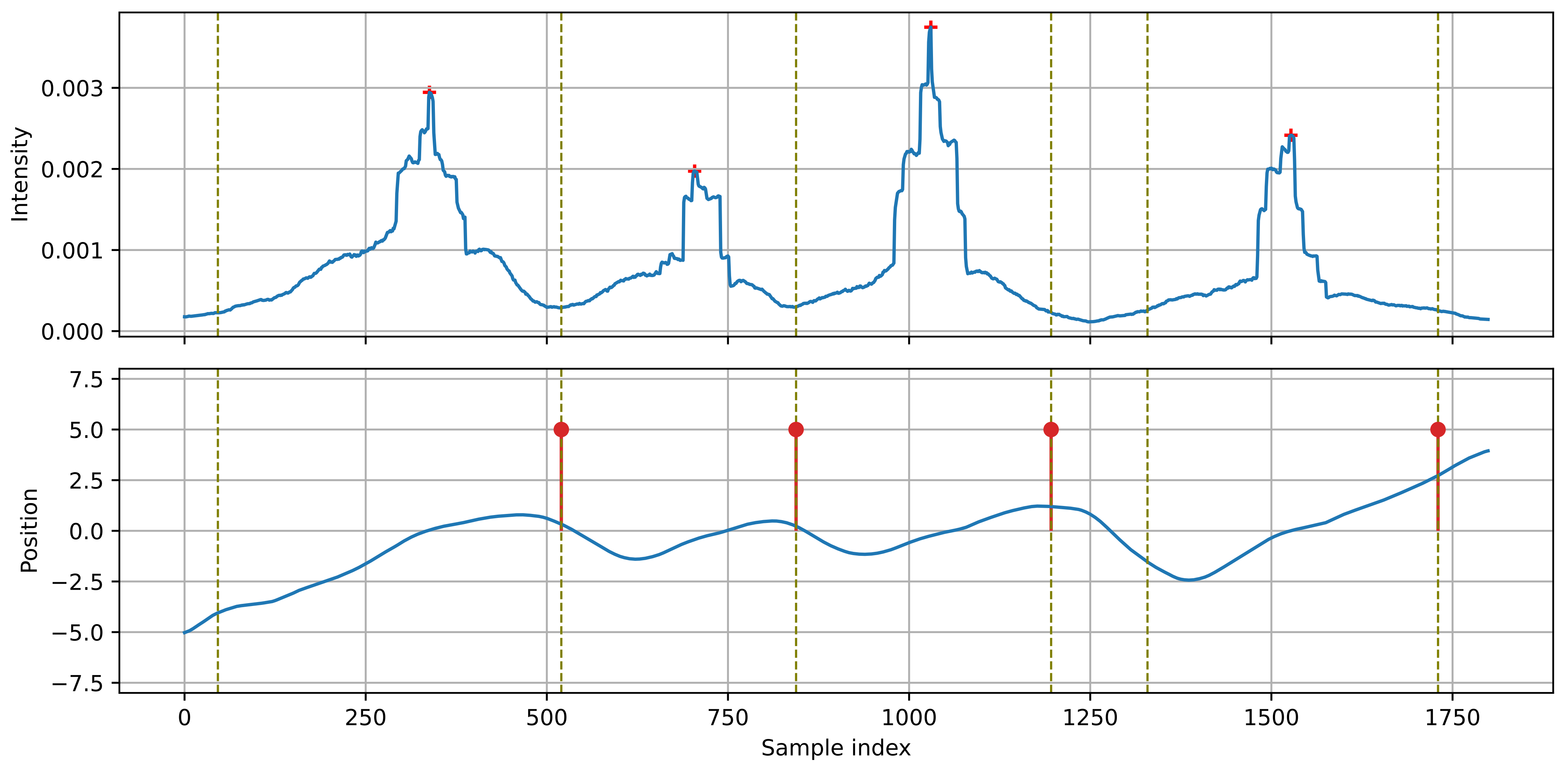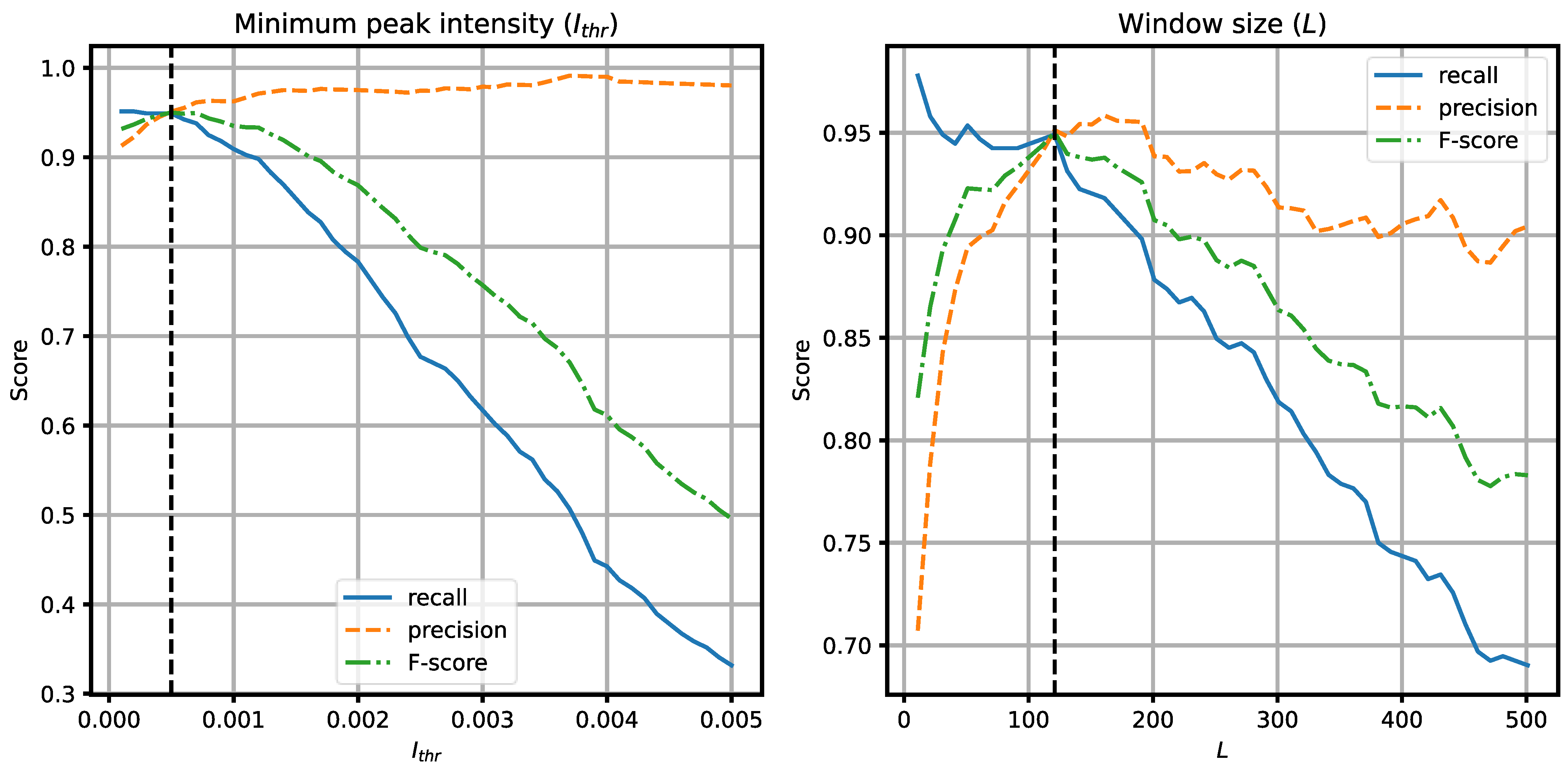Acoustic Detector of Road Vehicles Based on Sound Intensity
Abstract
:1. Introduction
2. Materials and Methods
2.1. Sound Intensity Calculation and Preprocessing
2.2. Acoustic Event Detection
2.3. Source Position and Velocity
2.4. The Decision Stage
- The event duration test: N > Nthr. This test eliminates short-term events that are usually caused by impulsive noise sources.
- The maximum intensity test: Imax > Ithr. Events with low sound intensity are discarded because they may not represent moving vehicles.
- The span test: s > sthr. It is expected that the movement of a vehicle is observed in a sufficiently wide range of positions. For a group of connected events (multiple vehicles moving close to each other), the span s should be calculated for the whole group, as the individual vehicles may have a limited span.
3. Experiments
3.1. Test Setup
3.2. Examples of Vehicle Detection
3.3. Parameter Tuning
3.4. Results
3.5. Comparison with Other Methods
4. Conclusions
Author Contributions
Funding
Institutional Review Board Statement
Informed Consent Statement
Data Availability Statement
Conflicts of Interest
References
- Du, R.; Santi, P.; Xiao, M.; Vasilakos, A.V.; Fischione, C. The sensable city: A survey on the deployment and management for smart city monitoring. IEEE Commun. Surv. Tutor. 2019, 21, 1533–1560. [Google Scholar] [CrossRef]
- Klein, L.A.; Mills, M.K.; Gibson, D.R.P. Traffic Detector Handbook, 3rd ed.; Report No. FHWA-HRT-06-108; Federal Highway Administration Research and Technology: Washington, DC, USA, 2006.
- Adnan, M.A.; Sulaiman, N.; Zainuddin, N.I.; Besar, T.B.H.T. Vehicle speed measurement technique using various speed detection instrumentation. In Proceedings of the 2013 IEEE Business Engineering and Industrial Applications Colloquium (BEIAC), Langkawi, Malaysia, 7–9 April 2013; pp. 668–672. [Google Scholar] [CrossRef]
- Guerrero-Ibáñez, J.; Zeadally, S.; Contreras-Castillo, J. Sensor Technologies for Intelligent Transportation Systems. Sensors 2018, 18, 1212. [Google Scholar] [CrossRef] [PubMed] [Green Version]
- Yamal, R.; Manaa, K.; Tabee’a, M.; Khalaf, L. Traffic control by digital imaging cameras. In Emerging Trends in Image Processing, Computer Vision and Pattern Recognition; Deligiannidis, L., Arabnia, H.R., Eds.; Morgan Kaufmann: Waltham, MA, USA, 2015; pp. 231–247. [Google Scholar] [CrossRef]
- Yang, Z.; Pun-Cheng, L.S.C. Vehicle detection in intelligent transportation systems and its applications under varying environments: A review. Image Vis. Comput. 2018, 69, 143–154. [Google Scholar] [CrossRef]
- Cygert, S.; Czyżewski, A. Vehicle detection with self-training for adaptative video processing embedded platform. Appl. Sci. 2020, 10, 5763. [Google Scholar] [CrossRef]
- Duffner, O.; Marlow, S.; Murphy, N.; O’Connor, N.; Smeanton, A. Road traffic monitoring using a two-microphone array. In Proceedings of the 118th Audio Engineering Society Convention, Barcelona, Spain, 28–31 May 2005; p. 6355. [Google Scholar]
- López-Valcarce, R.; Mosquera, C.; Pérez-González, F. Estimation of road vehicle speed using two omnidirectional microphones: A maximum likelihood approach. EURASIP J. Adv. Signal. Process. 2004, 8, 929146. [Google Scholar] [CrossRef] [Green Version]
- Ishida, S.; Liu, S.; Mimura, K.; Tagashira, S.; Fukuda, A. Design of acoustic vehicle count system using DTW. In Proceedings of the 23rd ITS World Congres, Melbourne, Australia, 10–14 October 2016; AP-TP0678. pp. 1–10. [Google Scholar]
- Ishida, S.; Mimura, K.; Liu, S.; Tagashira, S.; Fukuda, A. Design of simple vehicle counter using sidewalk microphones. In Proceedings of the 11th ITS EU Congress, Glasgow, Scotland, 6–9 June 2016; EU-TP0042. pp. 1–10. [Google Scholar]
- Ishida, S.; Kajimura, J.; Uchino, M.; Tagashira, S.; Fukoda, A. SAVeD: Acoustic vehicle detector with speed estimation capable of sequential vehicle detection. In Proceedings of the 21st International Conference on Intelligent Transportation Systems (ITSC), Maui, HI, USA, 4–7 November 2018. [Google Scholar] [CrossRef]
- Uchino, M.; Ishida, S.; Kubo, K.; Tagashira, S.; Fukuda, A. Initial design of acoustic vehicle detector with wind noise suppressor. In Proceedings of the 2019 IEEE International Conference Pervasive Computing and Communications Workshops, Kyoto, Japan, 11–15 March 2019; pp. 814–819. [Google Scholar] [CrossRef]
- Ishida, S.; Uchino, M.; Li, C.; Tagashira, S.; Fukuda, A. Design of acoustic vehicle detector with steady-noise suppression. In Proceedings of the IEEE Intelligent Transportation Systems Conference (ITSC), Auckland, New Zealand, 27–30 October 2019; pp. 2848–2853. [Google Scholar] [CrossRef]
- Kubo, K.; Li, C.; Ishida, S.; Tagashira, S.; Fukuda, A. Design of ultra low power vehicle detector utilizing Discrete Wavelet Transform. In Proceedings of the ITS Asia-Pacific Forum, Fukuoka, Japan, 8–10 May 2018; pp. 1–12. [Google Scholar]
- Na, Y.; Guo, Y.; Fu, Q.; Yan, Y. An acoustic traffic monitoring system: Design and implementation. In Proceedings of the 2015 IEEE 12th International Conference on Ubiquitous Intelligence and Computing, Beijing, China, 10–14 August 2015; pp. 119–126. [Google Scholar] [CrossRef]
- Toyoda, T.; Ono, N.; Miyabe, S.; Yamada, T.; Makino, S. Traffic monitoring with ad-hoc microphone array. In Proceedings of the 14th International Workshop on Acoustic Signal Enhancement (IWAENC), Juanles-Pins, France, 8–11 September 2014; pp. 318–322. [Google Scholar] [CrossRef]
- Marmaroli, P.; Odobez, J.; Falourd, X.; Lissek, H. A bimodal sound source model for vehicle tracking in traffic monitoring. In Proceedings of the19th European Signal Processing Conference, Barcelona, Spain, 29 August–2 September 2011; pp. 1327–1331. [Google Scholar]
- Gatto, R.C.; Forster, C.H.Q. Audio-based machine learning model for traffic congestion detection. IEEE Trans. Intell. Trans. Syst. 2020, 22, 7200–7207. [Google Scholar] [CrossRef]
- Bhattacharyya, S.; Andryzcik, S.; Graham, D.W. An acoustic vehicle detector and classifier using a reconfigurable analog/mixed-signal platform. J. Low Power Electron. Appl. 2020, 10, 6. [Google Scholar] [CrossRef] [Green Version]
- Czyżewski, A.; Kotus, J.; Szwoch, G. Estimating traffic intensity employing passive acoustic radar and enhanced microwave doppler radar sensor. Remote Sens. 2020, 12, 110. [Google Scholar] [CrossRef] [Green Version]
- Kotus, J.; Szwoch, G. Estimation of average speed of road vehicles by sound intensity analysis. Sensors 2021, 21, 5337. [Google Scholar] [CrossRef] [PubMed]
- Fahy, F. Sound Intensity, 2nd ed.; E & F.N. Spon: London, UK, 1995. [Google Scholar]
- Jacobsen, F. Sound intensity and its measurement and applications. Curr. Top. Acoust. Res. 2003, 3, 87–91. [Google Scholar]
- De Bree, H.E. An overview of microflown technologies. Acust. United Acta Acust. 2003, 89, 163–172. [Google Scholar]
- Piotto, M.; Ria, A.; Stanzial, D.; Bruschi, P. Design and characterization of acoustic particle velocity sensors fabricated with a commercial post-CMOS MEMS process. In Proceedings of the 20th International Conference Solid-State Sensors, Actuators and Microsystems & Eurosensors, Berlin, Germany, 23–27 June 2019; pp. 1839–1842. [Google Scholar] [CrossRef]
- Pjetri, O.; Wiegerink, R.J.; Krijnen, G.J.M. A 2D particle velocity sensor with minimal flow disturbance. IEEE Sens. J. 2016, 16, 8706–8714. [Google Scholar] [CrossRef]
- Kalman, R.E. A new approach to linear filtering and prediction problems. J. Basic Eng. 1960, 82, 35–45. [Google Scholar] [CrossRef] [Green Version]
- Labbe, R. Kalman and Bayesian filters in Python. Available online: http://nbviewer.ipython.org/github/rlabbe/Kalman-and-Bayesian-Filters-in-Python/blob/master/table_of_contents.ipynb (accessed on 8 November 2021).
- Kotus, J.; Szwoch, G. Calibration of acoustic vector sensor based on MEMS microphones for DOA estimation. Appl. Acoust. 2018, 141, 307–321. [Google Scholar] [CrossRef]
- Ballesteros, J.A.; Sarradj, E.; Fernández, M.D.; Geyer, T.; Ballesteros, M.J. Noise source identification with beamforming in the pass-by of a car. Appl. Acoust. 2015, 93, 106–119. [Google Scholar] [CrossRef]











| Hour | N | TP | FN | FP | Recall | Prec. | F-Score |
|---|---|---|---|---|---|---|---|
| Total | 5905 | 5590 | 315 | 233 | 0.95 | 0.96 | 0.95 |
| 12–13 | 420 | 395 | 25 | 21 | 0.94 | 0.95 | 0.94 |
| 13–14 | 452 | 429 | 23 | 22 | 0.95 | 0.95 | 0.95 |
| 14–15 | 409 | 378 | 31 | 22 | 0.92 | 0.94 | 0.93 |
| 15–16 | 329 | 313 | 16 | 8 | 0.95 | 0.98 | 0.96 |
| 16–17 | 267 | 253 | 14 | 11 | 0.95 | 0.96 | 0.95 |
| 17–18 | 288 | 258 | 30 | 20 | 0.90 | 0.93 | 0.91 |
| 18–19 | 264 | 252 | 12 | 6 | 0.95 | 0.98 | 0.97 |
| 19–20 | 157 | 153 | 4 | 4 | 0.97 | 0.97 | 0.97 |
| 20–21 | 109 | 104 | 5 | 1 | 0.95 | 0.99 | 0.97 |
| 21–22 | 40 | 38 | 2 | 1 | 0.95 | 0.97 | 0.96 |
| 22–23 | 27 | 27 | 0 | 0 | 1.00 | 1.00 | 1.00 |
| 23–24 | 16 | 16 | 0 | 0 | 1.00 | 1.00 | 1.00 |
| 00–01 | 18 | 18 | 0 | 0 | 1.00 | 1.00 | 1.00 |
| 01–02 | 26 | 26 | 0 | 2 | 1.00 | 0.93 | 0.96 |
| 02–03 | 38 | 38 | 0 | 0 | 1.00 | 1.00 | 1.00 |
| 03–04 | 198 | 189 | 9 | 2 | 0.95 | 0.99 | 0.97 |
| 04–05 | 304 | 291 | 13 | 8 | 0.96 | 0.97 | 0.97 |
| 05–06 | 303 | 281 | 22 | 12 | 0.93 | 0.96 | 0.94 |
| 06–07 | 364 | 349 | 15 | 20 | 0.96 | 0.95 | 0.95 |
| 07–08 | 360 | 343 | 17 | 11 | 0.95 | 0.97 | 0.96 |
| 08–09 | 380 | 363 | 17 | 10 | 0.96 | 0.97 | 0.96 |
| 09–10 | 357 | 345 | 12 | 18 | 0.97 | 0.95 | 0.96 |
| 10–11 | 401 | 375 | 26 | 10 | 0.94 | 0.97 | 0.95 |
| 11–12 | 378 | 356 | 22 | 24 | 0.94 | 0.94 | 0.94 |
| Dir. | N | TP | FN | FP | Recall | Prec. | F-Score |
|---|---|---|---|---|---|---|---|
| Both | 5905 | 5590 | 315 | 233 | 0.95 | 0.96 | 0.95 |
| L-R | 2928 | 2818 | 110 | 119 | 0.96 | 0.96 | 0.96 |
| R-L | 2977 | 2772 | 205 | 114 | 0.93 | 0.96 | 0.95 |
| No dir. | 5905 | 5686 | 219 | 137 | 0.96 | 0.98 | 0.97 |
| Algorithm | Sensor | N | Recall | Prec. | F-Score |
|---|---|---|---|---|---|
| The proposed method | intensity | 5905 | 0.95 | 0.96 | 0.95 |
| Czyżewski et al. [21] | intensity | 2953 | 0.87 | 0.93 | 0.90 |
| Duffner et al. [8] | dual microphones | 1000+ | 0.81 | N.A. | N.A. |
| Ishida et al. [10] | dual microphones | 116 | 0.82 | 0.92 | 0.87 |
| Ishida et al. [11] | dual microphones | 176 | 0.85 | 1.00 | 0.92 |
| Ishida et al. [12] | dual microphones | 178 | 0.83 | 0.84 | 0.83 |
| Uchino et al. [13] | dual microphones | 133 | 0.80 | 0.75 | 0.77 |
| Ishida et al. [14] | dual microphones | 93 | 0.86 | 0.99 | 0.92 |
| Kubo et al. [15] | dual microphones | 151 | 0.95 | 0.94 | 0.95 |
| Na et al. [16] | microphone array | 1093 | 0.86 | N.A. | N.A. |
| Toyoda et al. [17] | microphone array | 64 | 0.89 | 0.89 | 0.89 |
| Marmaroli et al. [18] | microphone array | 139 | 0.94 | 0.97 | 0.95 |
| Gatto et al. [19] | single microphone | 2314 | 0.99 | 0.96 | 0.97 |
Publisher’s Note: MDPI stays neutral with regard to jurisdictional claims in published maps and institutional affiliations. |
© 2021 by the authors. Licensee MDPI, Basel, Switzerland. This article is an open access article distributed under the terms and conditions of the Creative Commons Attribution (CC BY) license (https://creativecommons.org/licenses/by/4.0/).
Share and Cite
Szwoch, G.; Kotus, J. Acoustic Detector of Road Vehicles Based on Sound Intensity. Sensors 2021, 21, 7781. https://doi.org/10.3390/s21237781
Szwoch G, Kotus J. Acoustic Detector of Road Vehicles Based on Sound Intensity. Sensors. 2021; 21(23):7781. https://doi.org/10.3390/s21237781
Chicago/Turabian StyleSzwoch, Grzegorz, and Józef Kotus. 2021. "Acoustic Detector of Road Vehicles Based on Sound Intensity" Sensors 21, no. 23: 7781. https://doi.org/10.3390/s21237781
APA StyleSzwoch, G., & Kotus, J. (2021). Acoustic Detector of Road Vehicles Based on Sound Intensity. Sensors, 21(23), 7781. https://doi.org/10.3390/s21237781






